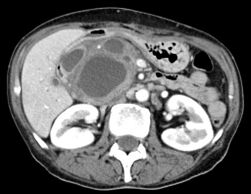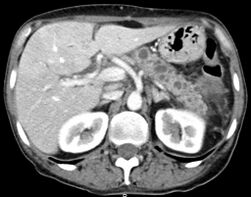Chronic Pancreatitis
From WikiLectures
Chronic pancreatitis is a long-term inflammation of the pancreas, that leads to irreversible changes and gradual tissue replacement with another tissue. In the advanced stages of the disease, exocrine and then endocrine pancreatic insufficiency develops, i.e. the production of insulin decreases and the development of diabetes occurs.
Chronic pancreatitis is characterized by recurring or persistent abdominal pain, accompanied by symptoms of pancreatic insufficiency.
Ethiology[edit | edit source]
The causes of chronic pancreatitis are multifactorial. The most important is long-term alcohol consumption, which occurs in about 40-90% of patients. Other causes include the use of analgesics, corticoids, thiazides (diuretics), hypercholesterolemia and hyperTAG are at risk.
- Hypercalcemia, professional exposure to organic solvents, viral infections, congenital anomalies (pancreas divisum) also contribute to it.
- Hereditary – CF.
Pathology[edit | edit source]
- We distinguish two basic forms - chronic pancreatitis, chronic obstructive pancreatitis.
- According to morphological criteria, we divide:
- chronic pancreatitis with focal necrosis;
- chronic pancreatitis with fibrosis (segmental or diffuse);
- "chronic pancreatitis" (without calcifications, with calcifications).
- Special type is obstructive chronic pancreatitis - it is characterized by dilatation of the excretory system, diffuse atrophy, regular diffuse fibrosis.
Association with chronic biliary disease[edit | edit source]
- Clinical features:
- permanent shock pain radiating from the midline of the upper abdomen (from the so-called May point) to both costal arches;
- weight loss, sometimes icterus;
- signs of exocrine insufficiency – bulky stools, steatorrhoea;
- latent or manifest diabetes;
- in an advanced stage – formation of pancreatogenic effusion – ascites, hydrothorax.
- Diagnosis - the basis of the diagnosis is:
- findings of duct dilatation and stricture
- edema and focal necrosis;
- fibrosis parenchyma of the pancreas (local, segmental, diffuse);
- pseudocysts and retention cysts.
- Diagnostics
- examination of the enzymatic activity of the exocrine pancreas;
- USG, CT, ERCP, MRI;
- puncture of the pancreas with a thin needle;
- angiography.
Therapy[edit | edit source]
- Conservative therapy:
- dietary measures, application of pancreatic digestive E, spasmolytics and regulators of intestinal peristalsis;
- diet - enough carbohydrates, lots of protein, just enough fat to avoid steatorrhea, medium chain TAG, vitamin and Ca replacement, no alcohol!
- dietary measures, application of pancreatic digestive E, spasmolytics and regulators of intestinal peristalsis;
- Endoscopic procedures:
- for decompression and release of the passage of pancreatic juice into the duodenum – in papilla stenosis.
- Indications for surgery:
- persistent pain resistant to treatment;
- the need of sanation of the bile ducts in case of biliary etiology;
- complications (cholestasis);
- cysts, abscesses, portal hypertension;
- suspicion of malignancy.
- Types of operational performance:
- Biopsy - FNB under CT or USG control or from exploratory laparotomy.
- Drainage Operations:
- pancreaticojejunoanastomosis;
- laterolateral, terminoterminal;
- only with a greatly dilated Wirsung - we make a Roux loop on the Y intestine and connect it to the dilated Wirsung's ductus.
- Pancreatic resection:
- duodenopancreatectomy partial (cephalic) – Whipple-Kauscher operation;
- left-sided pancreatic resection;
- resection of the head of the pancreas with preservation of the duodenum;
- very rarely total duodenopancreatectomy.
Conditions after pancreatitis – pancreatic pseudocysts[edit | edit source]
- Cavities inside or outside the pancreas.
- They do not have an epithelial lining, they are filled with fluid, less often necrotic masses.
- They are often connected to the pancreatic duct.
- Pseudocysts after acute pancreatitis are voluminous, practically always outside the pancreas. The walls are usually formed by neighboring organs – stomach, spleen, mesocolon, …
- Clinical features - small cysts are asymptomatic, larger ones - soreness with a feeling of fullness.
- Diagnosis - USG, palpation, x-ray, angiography - compression of arteries.
- Complications - hematemesis or bleeding directly from the cyst, stenosis of the upper GIT, icterus.
- Therapy:
- There is a possibility of spontaneous regression - we wait for the first 6 weeks (if it does not oppress or increase rapidly).
- After 6 weeks, spontaneous healing can no longer be expected.
- Cyst Decompression:
Links[edit | edit source]
Related Articles[edit | edit source]
- Pancreas
- Acute necrosis of pancreas
- Acute pancreatitis (diagnostic tests)
- Chronic pancreatitis (diagnostic tests)
External Links[edit | edit source]
References[edit | edit source]
- ZEMAN, Miroslav. Speciální chirurgie. 2. edition. Prague : Galén, 2006. 575 pp. ISBN 80-7262-260-9.
Source[edit | edit source]
- BENEŠ, Jiří. Study materials [online]. [cit. 6.5.2010]. <http://jirben.wz.cz>.



